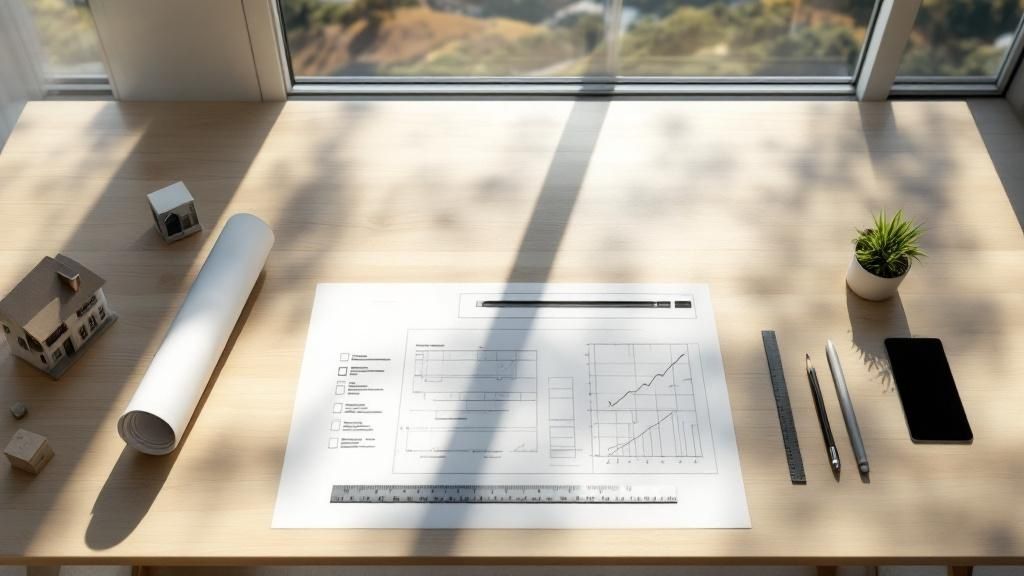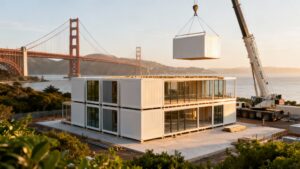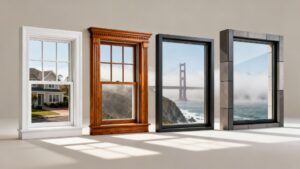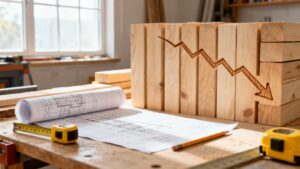Embarking on the journey to build a custom home in the Bay Area is an exciting venture, but its success hinges on meticulous planning. The process is a complex puzzle involving architects, contractors, and city planners, where every piece must fit perfectly. Overlooking a single detail can lead to significant delays and budget overruns, making a comprehensive plan essential.
This guide serves as your definitive building a custom home checklist, tailored for the unique challenges of the Berkeley, Oakland, and greater Bay Area market. We will break down the process into manageable phases, providing actionable insights for homeowners, builders, and designers alike. Think of it as your project management blueprint, designed to bring clarity and control to your build.
1. Budgeting and Financial Planning
Before the first shovel hits the dirt, a meticulously crafted financial plan is the most critical part of any successful custom home project. This step creates a realistic, comprehensive budget that accounts for every foreseeable expense. A well-structured budget is the foundation of your project, providing clarity and preventing costly overruns.
Deconstructing Your Custom Home Budget in the Bay Area
A common mistake is to only focus on the obvious construction costs. A truly comprehensive budget separates expenses into distinct categories to ensure nothing is overlooked, which is especially important in a high-cost market like the Bay Area.
- Hard Costs: These are the tangible expenses directly related to the physical construction, including all materials like lumber from a Berkeley building materials supplier, concrete, and windows. This also covers labor for framing, roofing, plumbing, and electrical work.
- Soft Costs: These are the indirect expenses necessary to move the project forward. This category includes architectural and engineering fees, land surveys, and permit fees from local municipalities like San Francisco or Oakland, which can be substantial.
- Contingency Fund: This is arguably the most important part of your budget. A contingency reserve, typically 15-20% of total costs in the Bay Area, is a non-negotiable safety net for unexpected site conditions or material price increases.
Actionable Tips for Financial Success
To keep your project on track, follow these proven strategies:
- Get Multiple Quotes: Never accept the first bid. Obtain detailed quotes from at least three licensed Bay Area contractors, architects, and major suppliers.
- Research Local Costs: Building costs in the Bay Area are among the highest in the nation. The National Association of Home Builders (NAHB) provides data that can help you understand the average cost per square foot in our region.
- Factor in All Expenses: Remember to budget for temporary housing, landscaping, furniture, and potential property tax increases after the home is complete.
- Document Everything: Keep meticulous records of all expenditures. This discipline helps you stay on budget and is crucial for tracking tax-deductible expenses.
2. Site Selection and Land Acquisition
Once your financial plan is in place, the next monumental step is choosing where your custom home will stand. Site selection is far more than just buying land; it is about finding the canvas for your vision. A thoughtful approach to land acquisition is a cornerstone of the building a custom home checklist.

Image Alt Text: A graded lot in the Bay Area hills, prepped for a custom home build, showing the importance of site selection.
Evaluating a Potential Bay Area Property
Evaluating a potential property requires a multi-faceted approach, especially in diverse landscapes like the Oakland Hills or coastal regions. A thorough evaluation breaks down the site into key components.
- Physical and Environmental Factors: This covers the land itself. Key considerations include topography (slope and grade), soil stability (crucial in seismic zones), natural drainage, and sun exposure to maximize passive solar gains.
- Logistical and Utility Factors: This involves the practical services required. You must verify access to essential utilities like water, sewer, electricity, and high-speed internet. Connecting these can be complex and costly in hillside or rural Bay Area locations.
- Regulatory and Legal Factors: These are the invisible but crucial rules governing the property. This includes local zoning ordinances, setback requirements, homeowners' association (HOA) covenants, and any easements.
Actionable Tips for Site Acquisition
To secure the perfect lot and avoid costly surprises, apply these proven strategies:
- Conduct Thorough Due Diligence: Hire a geotechnical engineer for soil tests and a licensed surveyor to confirm property boundaries.
- Visit at Various Times: Spend time on the property at different times of the day to understand sun patterns, neighborhood noise, and traffic.
- Investigate Zoning and Covenants: Obtain a copy of the local zoning regulations and any HOA rules before making an offer. These will define what you can build.
- Assess Future Development: Research long-term development plans for the surrounding area to protect your property value and quality of life.
3. Design and Architectural Planning
This is where your vision begins to take physical form. Design and architectural planning is the collaborative process of translating your ideas into a set of detailed, buildable blueprints. This phase is a cornerstone of any building a custom home checklist, as it creates the definitive roadmap for your team.

Image Alt Text: An architect's desk with blueprints, a model home, and drafting tools, symbolizing the design phase of a custom home.
Deconstructing Your Architectural Plans
A complete set of construction documents is far more detailed than just floor plans, ensuring clarity and precision for every trade involved.
- Schematic Design: This is the initial, high-level conceptual phase where your architect creates rough sketches of the floor plan and exterior elevations.
- Design Development (DD): Plans are refined with greater detail. Specific materials are chosen, and Bay Area windows and doors placements are finalized. Dimensions become precise.
- Construction Documents (CDs): This is the most detailed set of drawings and specifications. It includes everything the builder needs to construct the house and what the local building department needs to issue permits.
Actionable Tips for Design Success
To ensure your design phase yields a home you love, follow these proven strategies:
- Create a Vision Board: Collect inspiration from magazines, websites, and photos. A clear visual guide helps your architect understand your aesthetic goals.
- Design for the Future: Consider how your family’s needs might change. Plan for aging-in-place features or smart home technology integration.
- Prioritize Functionality: Think through your daily routines and design spaces that support them. A beautiful home that doesn't function well will cause frustration.
- Future-Proof Your Home: As part of your home's sustainable design, plan for electric vehicle integration. It is wise to consult a technical guide on installing home EV chargers to ensure your electrical system is ready.
4. Permits and Legal Requirements
Navigating the intricate maze of government regulations is a pivotal phase. Securing the correct permits and adhering to legal requirements is a critical process that ensures your home is safe, compliant, and legally sound. Overlooking this stage is a common mistake that can lead to costly fines and significant delays.
Navigating Bay Area Building Codes
Successfully managing the regulatory side of your build requires a proactive and organized approach, especially given California's stringent codes.
- Building Permits: This is the primary approval from your local building department that allows construction to begin. It certifies that your plans meet structural, safety, and zoning requirements.
- Ancillary Permits: You may need several other permits for electrical, plumbing, mechanical (HVAC), demolition, and grading.
- Inspections and Sign-Offs: A permit initiates a series of mandatory inspections at various milestones. Each stage must be approved by a city official before you can proceed.
Complying with California's Title 24
In the Bay Area, all new residential construction must adhere to the rigorous Title 24 energy efficiency standards. According to the California Energy Commission, these standards dictate requirements for insulation, high-performance windows, and efficient HVAC systems. This focus on sustainability is a key consideration for any local build.
Actionable Tips for Legal and Regulatory Success
To streamline the permitting process, integrate these strategies into your plan:
- Start Early: Begin discussions with your local building department during the design phase to prevent expensive redesigns.
- Hire Local Expertise: Work with an architect and contractor experienced in your specific municipality, whether it's Berkeley, Oakland, or another Bay Area city.
- Maintain Meticulous Records: Keep organized copies of all applications, issued permits, and inspection reports.
- Budget for Fees: Permit and inspection fees can be substantial. Factor these soft costs into your initial budget.
5. Contractor Selection and Management
Choosing your general contractor is one of the most consequential decisions you will make. This professional will be your day-to-day partner, responsible for translating plans into reality. A skilled, trustworthy contractor is the linchpin of a successful project.
Vetting Your Bay Area General Contractor
Finding the right contractor goes beyond picking the lowest bid. A thorough vetting process is essential to protect your investment.
- Credentials and Reputation: A qualified contractor must have a current state license, adequate liability insurance, and worker's compensation coverage. Investigate their reputation through online reviews and local building associations.
- Experience and Portfolio: Select a builder whose portfolio includes homes similar to yours in style and complexity. A contractor specializing in Eichler-style renovations may have different skills than one who builds modern hillside homes.
- Communication and Compatibility: You will be communicating with your contractor almost daily. It is vital that your communication styles align.
Actionable Tips for Contractor Success
To secure a strong partnership with your builder, follow these proven strategies:
- Get Three Detailed Bids: Solicit comprehensive, itemized bids from at least three different contractors.
- Check References Thoroughly: Call past clients and ask about their experience with communication, budget adherence, and how the contractor handled challenges.
- Visit a Current Job Site: Ask to visit an active construction site to see their organization, cleanliness, and quality of work firsthand.
- Establish Clear Communication Protocols: Agree on a communication plan before signing a contract. Your builder's ability to source high-quality materials is also a key factor; you can learn more about the importance of durable building materials on Truittandwhite.com to inform your discussions.
6. Material Selection and Procurement
Once your team is in place, the focus shifts to the tangible components of your home. This stage involves a careful balancing act of quality, cost, aesthetics, and availability. Making informed choices here is a vital part of any building a custom home checklist.

Image Alt Text: A well-organized lumberyard near Oakland, showcasing stacks of lumber and building materials ready for procurement.
Choosing Materials for Bay Area Homes
Selecting materials involves a systematic approach, with special attention to the Bay Area's climate and sustainability priorities.
- Structural and Rough-In Materials: These form the skeleton of your home, including framing lumber, sheathing, roofing, and insulation. For energy-efficient heating and cooling, exploring options like air source heat pumps is a crucial step.
- Exterior Finishes: These materials define your home's curb appeal and protect it from our coastal climate. This category covers siding, exterior trim, and high-performance Bay Area windows and doors that resist moisture and improve energy efficiency. For example, Marvin and Andersen windows are popular choices for their durability and Energy Star ratings.
- Interior Finishes: These are the elements you see and touch every day, such as flooring, tile, cabinetry, and countertops.
Actionable Tips for Procurement Success
To ensure a smooth supply chain, follow these proven strategies:
- Order Well in Advance: Lead times for custom items like windows, doors, and cabinets can be several months long.
- Plan for On-Site Storage: Materials delivered to the site must be protected from weather and theft. Plan for secure, dry storage areas.
- Document Everything: Keep meticulous records of all material specifications, purchase orders, and warranties.
- Establish Supplier Relationships: Work with a reputable lumberyard near Oakland or Berkeley. Establishing accounts can lead to better pricing and expert advice.
7. Timeline and Project Management
A well-defined schedule is the roadmap that guides your entire construction journey. Without a robust timeline and active project management, a custom home build can quickly fall victim to delays and cost overruns. This is an indispensable element of any building a custom home checklist.
Deconstructing Your Custom Home Timeline
A successful project timeline breaks the build into logical phases with clear milestones, creating a transparent path forward.
- Pre-Construction Phase: This stage covers finalizing architectural plans, securing permits, and finalizing contracts. In the Bay Area, this can take 6-12 months alone.
- Construction Phase: This is the core of the build, from excavation to the "dry-in" stage and completion of interior and exterior finishes. A typical custom build takes 12-18 months.
- Post-Construction Phase: This final stage includes detailed interior work, final inspections, landscaping, and the final walkthrough (punch list).
Putting Timeline Management into Practice
Effective project management is non-negotiable. A Gantt chart, a visual bar chart that illustrates a project schedule, is a cornerstone of construction management, allowing builders to track dependencies and manage critical path activities.
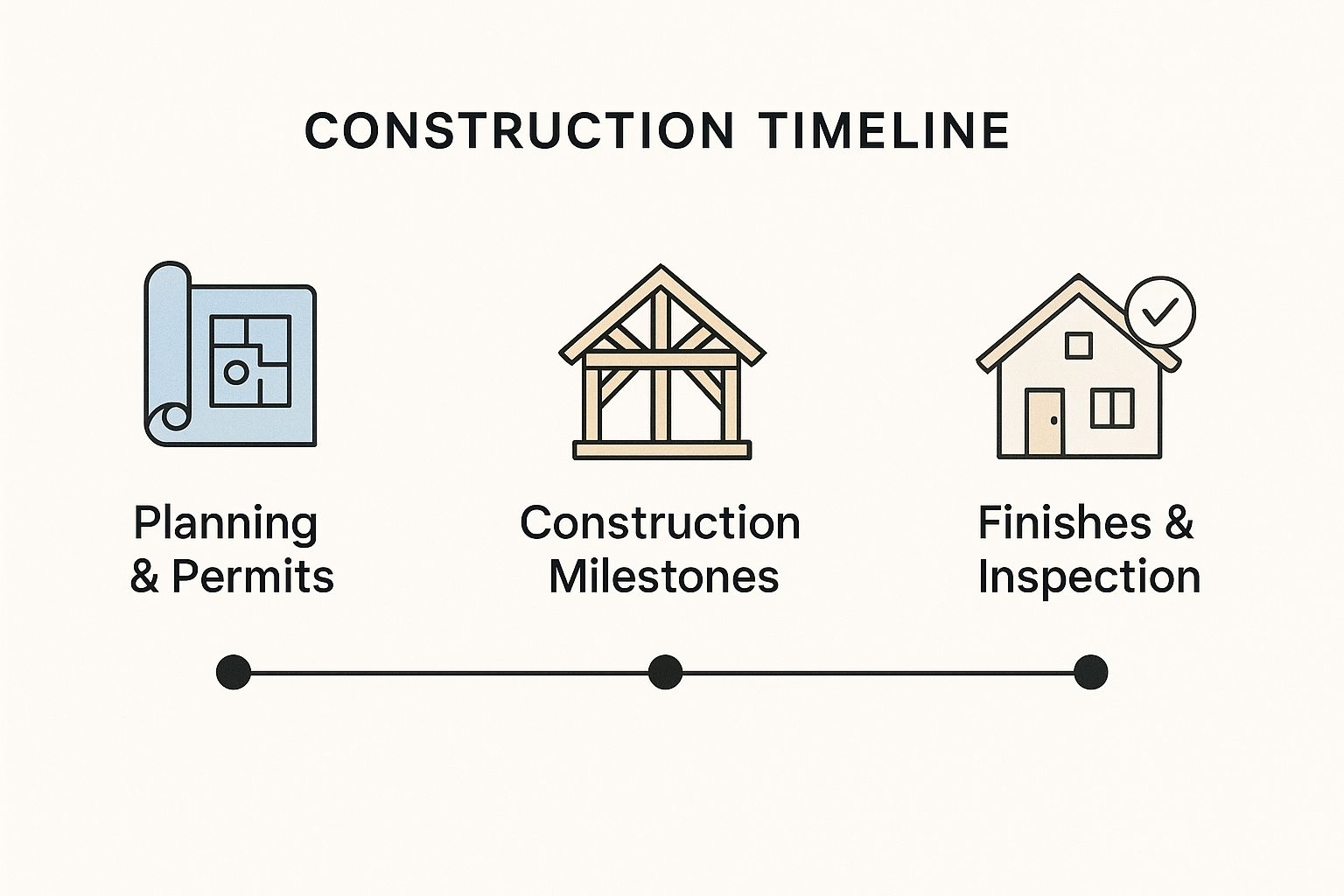
Image Alt Text: An infographic showing the key phases of a custom home build timeline: Pre-Construction, Construction, and Post-Construction.
This infographic highlights the three macro-stages of a build, providing a clear overview of the project's flow.
Actionable Tips for Project Success
To maintain momentum and manage your schedule effectively, adopt these proven strategies:
- Build in a Buffer: Experienced builders always incorporate buffer time into the schedule to account for weather delays or material backorders.
- Use Project Management Tools: Utilize software to track progress, communicate with stakeholders, and manage tasks.
- Hold Regular Meetings: Schedule weekly meetings with your builder to review progress and address challenges.
- Order Materials Proactively: Work with your builder to order long-lead-time items well in advance. You can learn more about the detailed construction process in San Francisco and its typical sequencing.
- Prioritize Site Security: Safeguarding the construction site is a critical part of project oversight. For a comprehensive guide, consult an ultimate construction site security checklist.
Frequently Asked Questions (FAQs)
1. How long does it take to build a custom home in the Bay Area?
On average, building a custom home in the Bay Area takes 18 to 24 months from initial design to final completion. The pre-construction phase (design, permits) can take 6-12 months, with construction itself lasting another 12-18 months, depending on complexity and location.
2. What is a realistic contingency fund for a Bay Area build?
For a custom home project in the Bay Area, a contingency fund of 15-20% of your total construction cost is recommended. This higher percentage accounts for the region's potential for unforeseen seismic upgrades, challenging hillside site conditions, and fluctuating material costs.
3. What are the most important building materials for a Bay Area climate?
Prioritize materials that address our climate's unique challenges. This includes high-performance, energy-efficient windows (like those from Marvin or Andersen), durable siding that resists moisture and sun, and robust framing lumber. Also, using fire-resistant materials is crucial in many parts of the region.
4. How do I find a good architect and contractor in Berkeley or Oakland?
Start by asking for recommendations from trusted sources, including material suppliers like Truitt & White. Look for professionals with a strong portfolio of projects similar to yours in the local area, check their licenses with the CSLB, and thoroughly vet their references.
5. Do I need a geotechnical report for my property?
Yes, in almost all cases in the Bay Area, a geotechnical (soils) report is essential and often required by local building departments. This report analyzes soil stability, seismic risks, and groundwater levels, informing the foundation design and ensuring the home is built safely.
Your Trusted Partner in Building Excellence
Embarking on a custom home build is one of the most significant projects you can undertake. This comprehensive building a custom home checklist is a strategic roadmap designed to empower you with clarity and control at every stage. By meticulously navigating each phase, you transform a potentially overwhelming process into a series of manageable milestones.
Key Takeaways for a Successful Build
- Financial Discipline is Foundational: A detailed, realistic financial plan with a robust contingency fund is non-negotiable.
- Your Team is Your Greatest Asset: The success of your custom home hinges on the expertise of your architect, builder, and reliable suppliers like Truitt & White.
- Material Selection Defines Quality: Choose high-impact items like windows, doors, and lumber that are suited for the demanding Bay Area environment.
- Documentation is Your Safety Net: Maintaining meticulous records of contracts, change orders, and permits is your best defense against disputes.
Your Actionable Next Steps
- Refine Your Vision and Budget: Start a digital board (like Pinterest) for visual inspiration and meet with a lender to establish a firm budget.
- Begin Assembling Your Core Team: Research local Bay Area architects and custom home builders, review their portfolios, and check references.
- Explore Material Options: Visit local showrooms and building supply centers. Seeing materials like Marvin windows or siding options firsthand is invaluable.
Building a custom home is about creating a space that is a true reflection of you. It's a legacy project that requires patience, precision, and partnership. By leveraging a detailed building a custom home checklist and aligning with expert partners, you can ensure the process is as fulfilling as the final result.
For premium building materials and expert guidance, Bay Area builders, contractors, and homeowners trust Truitt & White. From foundational lumber to high-performance windows and doors, our team provides the quality products and knowledge essential for your custom home. Visit our Berkeley showroom for expert advice or explore our inventory online. Visit Truitt and White to see how we can help bring your vision to life.


